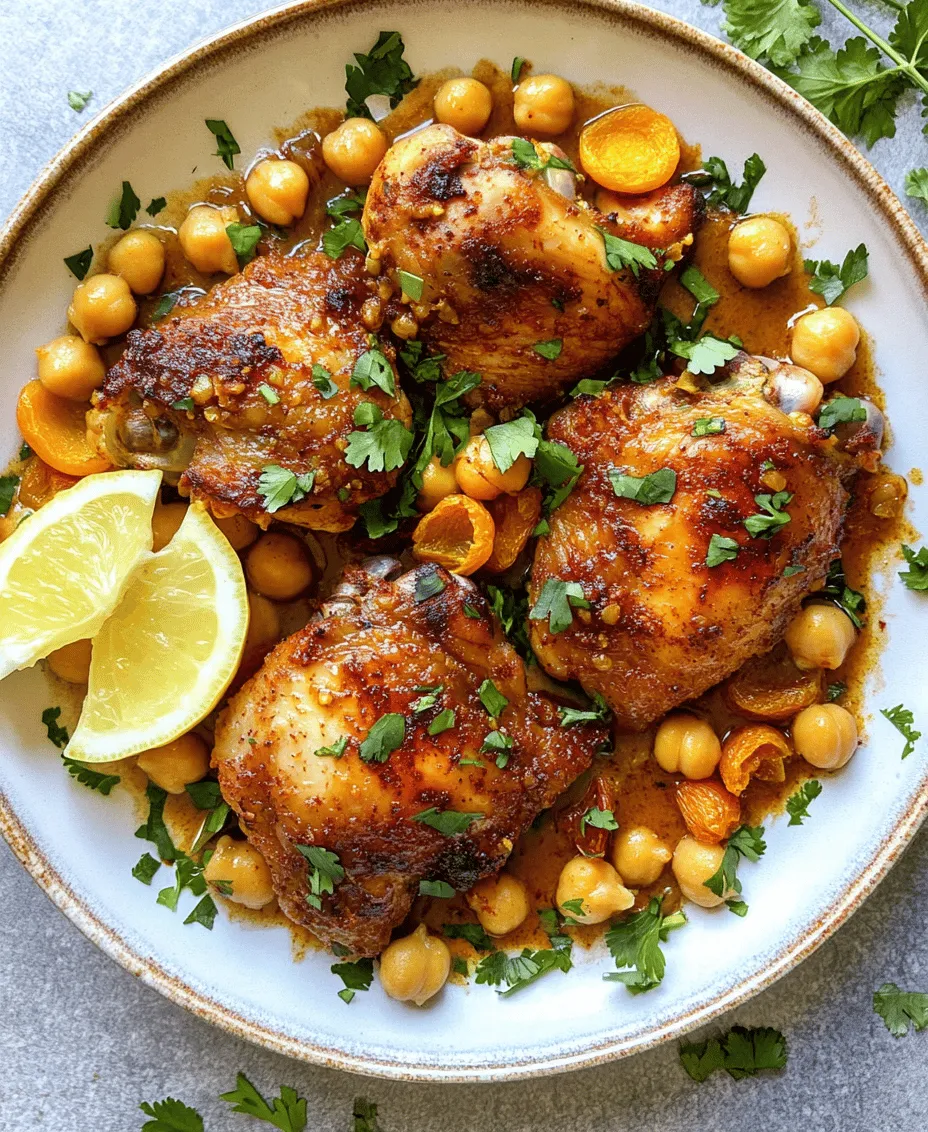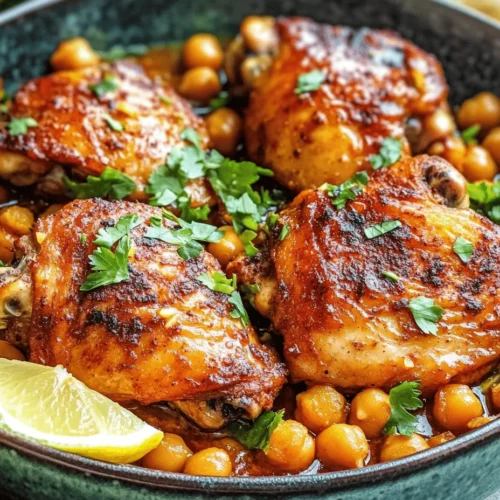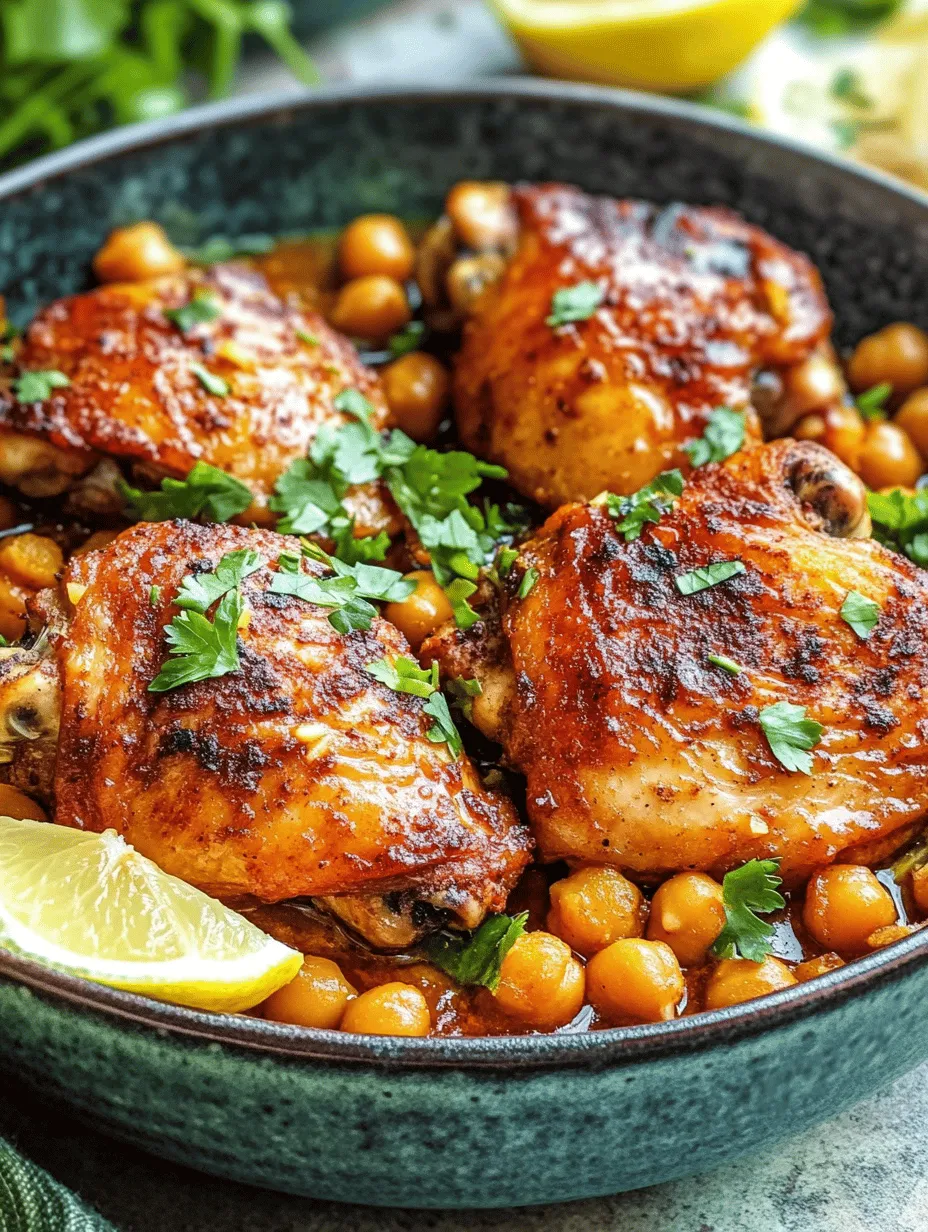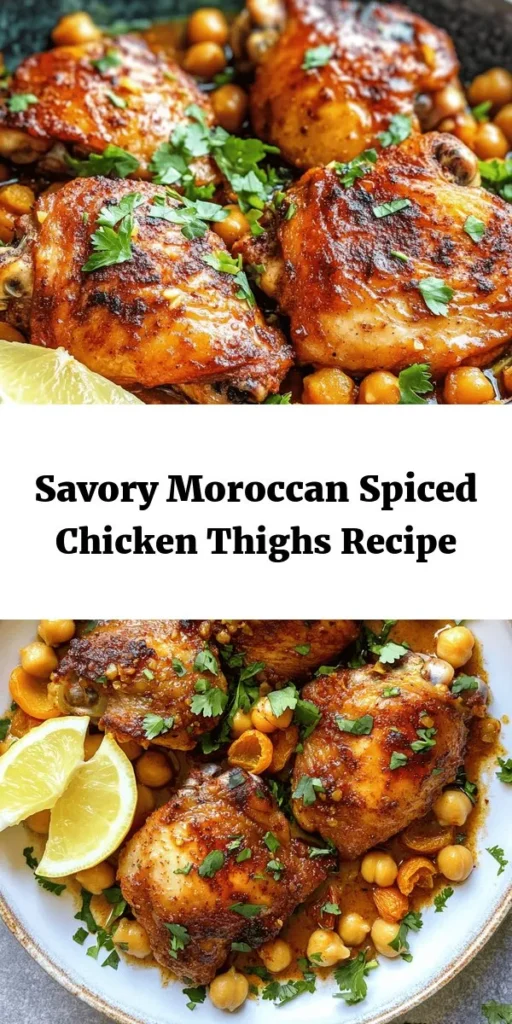Introduction
Moroccan cuisine is a vibrant tapestry of flavors, textures, and aromas, reflecting the diverse history and culture of the region. Known for its bold use of spices and fresh ingredients, Moroccan cooking invites diners to experience a delightful journey through its culinary landscape. The heart of this cuisine lies in its unique spice blends, which not only enhance the taste of dishes but also offer various health benefits.
At the center of our culinary exploration today is the Moroccan Spiced Chicken recipe. This dish showcases the rich aromatic profile typical of Moroccan cooking. Succulent chicken thighs are complemented with an array of spices, creating a meal that is not only delicious but also perfect for family gatherings or weeknight dinners. The combination of sweet and savory elements makes Moroccan Spiced Chicken a favored choice for those looking to spice up their dinner routine.
Understanding Moroccan Cuisine
Traditional Moroccan cuisine is characterized by its use of a variety of ingredients, many of which are staples in the region. The foundation of many Moroccan dishes includes fresh vegetables, grains, and legumes, complemented by an array of meats, particularly lamb and chicken. Lentils and chickpeas are also prominent, offering hearty protein sources that are both satisfying and nourishing.
Spices play a pivotal role in Moroccan cooking. Cumin, coriander, cinnamon, and smoked paprika are just a few examples of the aromatic ingredients that contribute to the distinct flavor profiles found in Moroccan dishes. Each spice brings its unique character, creating layers of flavor that tantalize the palate. For instance, cumin adds warmth and earthiness, while coriander contributes a hint of citrusy brightness. Cinnamon, often associated with sweetness, also enhances savory dishes, providing depth and complexity.
The influence of various cultures on Moroccan cooking is another fascinating aspect. Moroccan cuisine has been shaped by centuries of trade and migration, incorporating elements from Berber, Arab, Mediterranean, and African culinary traditions. This rich history is evident in the diversity of flavors and techniques used across the country. As a result, Moroccan food is not just about sustenance; it is a celebration of the cultural heritage of the Moroccan people.
Health Benefits of Key Ingredients
The health benefits of the ingredients used in Moroccan Spiced Chicken are noteworthy. Chicken thighs are a flavorful and juicy cut of meat, providing a good source of protein. They are also rich in essential vitamins and minerals, including B vitamins, which support energy metabolism, and selenium, which plays a crucial role in immune function.
Chickpeas, another key ingredient in this recipe, are an excellent source of plant-based protein and dietary fiber. They help to keep you feeling full, making them a great addition to any meal. The fiber in chickpeas also aids in digestion and supports heart health by helping to lower cholesterol levels.
Dried apricots and honey add a touch of natural sweetness to the dish. Dried apricots are high in antioxidants and provide important nutrients such as vitamin A and potassium, contributing to overall health. Honey, known for its natural sweetness, also offers antimicrobial properties and can soothe digestive issues.
Olive oil, a staple in Mediterranean diets, is rich in monounsaturated fats, which are beneficial for heart health. It is also packed with antioxidants, which help combat inflammation. Fresh herbs like cilantro and parsley not only enhance the flavor but also offer additional nutrients, including vitamins A, C, and K, further boosting the nutritional profile of the dish.
Ingredients Breakdown
Creating the Moroccan Spiced Chicken involves a selection of carefully chosen ingredients that work harmoniously together. Below is a detailed list of the ingredients needed for this flavorful dish, along with suggestions for substitutions and sourcing authentic Moroccan spices.
Ingredients
1. Chicken Thighs: Approximately 2 pounds of boneless, skinless chicken thighs are ideal for this recipe. The dark meat remains tender and juicy during cooking, making it perfect for absorbing the spices.
2. Chickpeas: One can (about 15 ounces) of chickpeas, drained and rinsed. Alternatively, you can use dried chickpeas that have been soaked and cooked.
3. Dried Apricots: About 1 cup of chopped dried apricots. These provide natural sweetness and a chewy texture that contrasts nicely with the other ingredients.
4. Honey: 2 tablespoons of honey for added sweetness. Maple syrup can be used as a substitute for a vegan option.
5. Olive Oil: 3 tablespoons of extra virgin olive oil for cooking and enhancing flavor.
6. Spices:
– Cumin: 2 teaspoons of ground cumin.
– Coriander: 2 teaspoons of ground coriander.
– Cinnamon: 1 teaspoon of ground cinnamon.
– Smoked Paprika: 1 teaspoon of smoked paprika for a smoky flavor.
– Salt and Pepper: To taste, enhancing the overall flavor profile.
7. Fresh Herbs: 1/4 cup of chopped cilantro and parsley, which can be added at the end for freshness and garnish.
Ingredient Substitutions
– Chicken Alternatives: If you prefer a lighter option, boneless, skinless chicken breasts can be used, though they may require careful cooking to prevent dryness. For a vegetarian alternative, consider using firm tofu or tempeh, marinated in the same spices.
– Dried Fruits: While dried apricots are traditional, you can substitute them with other dried fruits such as raisins, figs, or dates, depending on your preference.
– Chickpeas: If chickpeas are not available, you can use other legumes such as lentils or black beans, but be mindful that cooking times may vary.
Sourcing Authentic Moroccan Spices
The spices used in Moroccan cooking are essential for achieving the authentic flavors characteristic of the cuisine. When sourcing spices, look for high-quality, fresh products. Local markets, specialty spice shops, or online retailers often carry authentic Moroccan spices. Consider purchasing whole spices and grinding them at home for the best flavor. This approach ensures that the spices retain their aromatic oils, delivering a more robust flavor to your dishes.
By understanding the rich heritage of Moroccan cuisine, the health benefits of the ingredients, and the necessary components for the Moroccan Spiced Chicken recipe, you are well on your way to creating a delicious and nutritious meal that will impress your family and friends alike. Now let’s dive into the step-by-step instructions for preparing this aromatic dish.

Preparation Steps for Moroccan Spiced Chicken
Searing the Chicken
To begin your Moroccan spiced chicken, the first crucial step is searing the chicken. This technique not only enhances flavor but also lends a beautiful golden-brown color to the meat. Searing creates a savory crust on the chicken, which locks in juices and infuses the dish with richness. To do this, heat a generous amount of olive oil in a large skillet over medium-high heat. Once the oil shimmers, carefully place the chicken pieces in the skillet, ensuring not to overcrowd the pan, as this will lower the temperature and prevent proper browning. Sear the chicken for about 5-7 minutes on each side until golden brown. Once done, remove the chicken from the pan and set it aside, allowing the fond (the caramelized bits left in the pan) to develop and enhance the flavor of the dish.
Sautéing Aromatics
Next, it’s time to build a flavor base by sautéing aromatics. In the same skillet, add finely chopped onions and minced garlic to the remaining oil and fond. The sweetness of the onions combined with the pungency of garlic creates a fragrant aroma that is the hallmark of many Mediterranean dishes. Sauté the onions until they become translucent and soft, about 5 minutes, stirring frequently to prevent burning. Once the onions are soft, add minced garlic and sauté for an additional minute until fragrant, being cautious not to let the garlic burn, as it can become bitter.
Adding Spices
Now comes the exciting part—adding spices. The Moroccan spice blend typically includes cumin, coriander, cinnamon, and paprika, each contributing its unique flavor profile. To maximize the flavor release, toast the spices in the sautéed onion and garlic mixture for about 1-2 minutes. This process allows the essential oils to be released, intensifying their flavors. Stir constantly to prevent burning. The warm, inviting aroma of the spices wafting through your kitchen will have everyone eagerly anticipating dinner.
Building the Sauce
With the spices toasted, it’s time to build the sauce. Deglaze the pan by adding a splash of chicken broth or water, scraping up the browned bits from the bottom of the skillet. This step is essential as it incorporates all those rich flavors back into the sauce. Next, add canned chickpeas (rinsed and drained) and diced dried apricots. The chickpeas provide protein and a hearty texture, while the apricots add a subtle sweetness that balances the spices beautifully. Stir everything together, then return the seared chicken to the skillet, ensuring it is nestled within the sauce.
Simmering
To make the chicken tender and allow it to absorb all those incredible flavors, cover the skillet and reduce the heat to low. Let the chicken simmer for about 30-35 minutes. The low, gentle heat will cook the chicken through without drying it out, resulting in juicy and succulent pieces. Check the chicken periodically; if the sauce thickens too much, add a bit more broth or water. When the chicken is fully cooked (with an internal temperature of 165°F), it will be infused with the Moroccan spices, and the flavors will meld beautifully.
Serving Suggestions
When it comes to serving Moroccan spiced chicken, there are several options that complement the dish wonderfully. Traditional accompaniments include fluffy couscous, which can absorb the sauce and provide a delightful texture contrast. Alternatively, serve the chicken over fragrant rice, seasoned with herbs and spices, or alongside crusty bread to soak up the sauce. Adding a fresh salad with crisp greens and a tangy vinaigrette will provide a refreshing balance to the rich flavors of the chicken. Consider garnishing the dish with fresh cilantro or parsley for a pop of color and an extra layer of flavor.
Flavor Profiles and Pairing Suggestions
The robust flavor profiles of Moroccan spiced chicken stem from its rich medley of spices. The earthy cumin and coriander create a warm foundation, while cinnamon adds a subtle sweetness that is characteristic of Moroccan cuisine. The paprika contributes a gentle heat, making the dish inviting without overwhelming the palate.
When it comes to pairing beverages with this dish, consider a light-bodied red wine such as Pinot Noir or a fruity rosé to enhance the flavors without overshadowing them. If you prefer non-alcoholic options, a refreshing mint tea or a citrus-infused sparkling water would complement the meal beautifully. Additionally, side dishes such as roasted vegetables or a Moroccan carrot salad can provide a refreshing contrast to the spices and round out the meal perfectly.
Cultural Significance of Moroccan Spiced Chicken
Moroccan spiced chicken is more than just a delicious meal; it embodies the rich cultural traditions of Morocco. In Moroccan culture, food is often enjoyed as a communal experience, where families and friends gather around a table to share dishes and stories. The act of sharing meals fosters connection and strengthens bonds, as everyone digs into a central platter of food, serving themselves. This recipe, with its vibrant spices and hearty ingredients, fits seamlessly into this narrative, encouraging togetherness and shared enjoyment.
Sharing meals is a cherished tradition in Morocco, where hospitality plays a crucial role in social interactions. The Moroccan proverb, “A guest is a gift from God,” reflects this cultural importance. Preparing and sharing a dish like Moroccan spiced chicken not only nourishes the body but also nourishes relationships, making it ideal for gatherings or special occasions.
Conclusion
In summary, Moroccan spiced chicken is a delightful recipe that combines rich flavors with ease of preparation. The nutritional benefits of this dish, with its lean protein from chicken and fiber from chickpeas, make it a wholesome choice for any meal. The process of cooking, from searing to simmering, not only enhances the flavors but also creates a fragrant atmosphere in your kitchen that is sure to excite your diners.
I invite you to try this Moroccan spiced chicken recipe and explore the joys of Moroccan cooking. Whether you’re hosting a dinner party or enjoying a cozy night in, this dish is sure to impress your family and friends. Don’t forget to share the experience and the meal, as the true essence of Moroccan dining lies in the act of coming together to enjoy good food and great company. Happy cooking!



